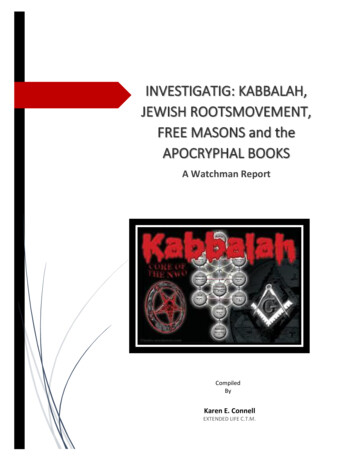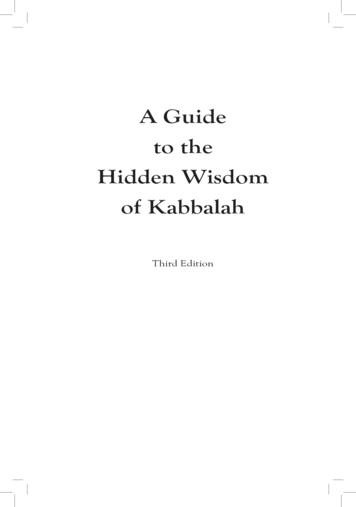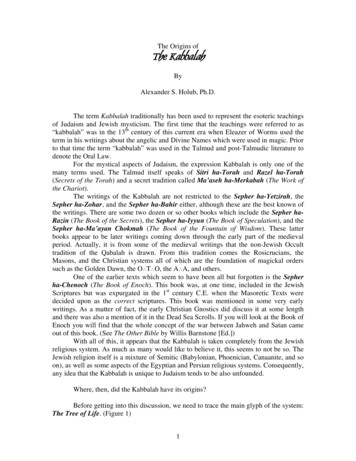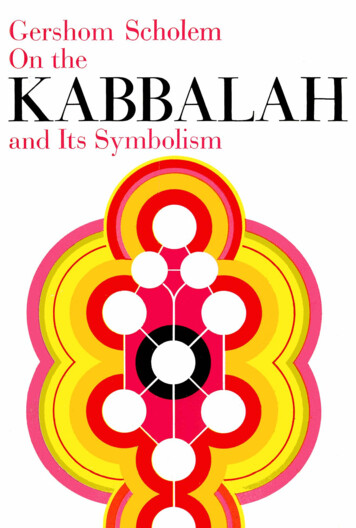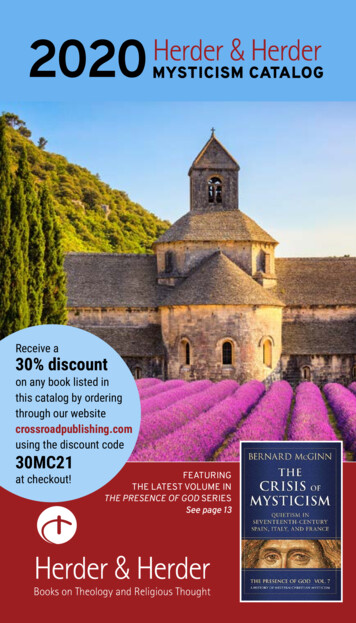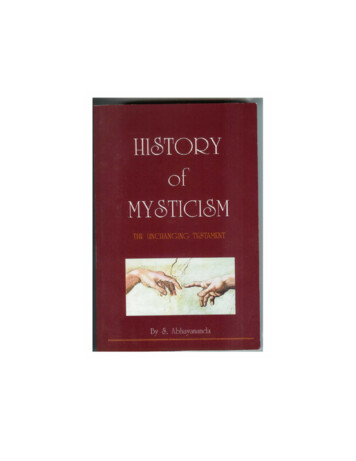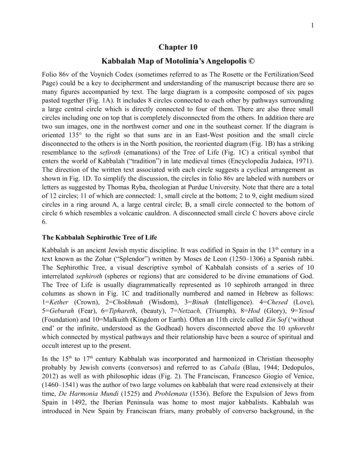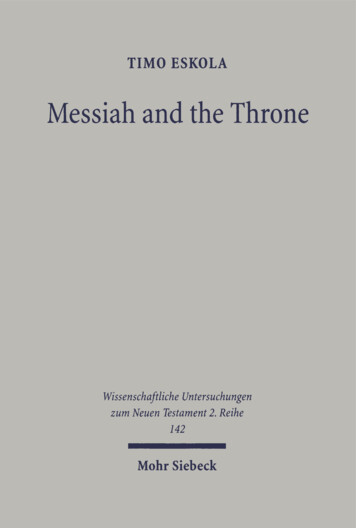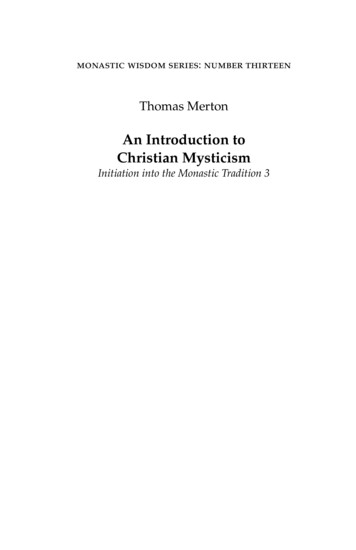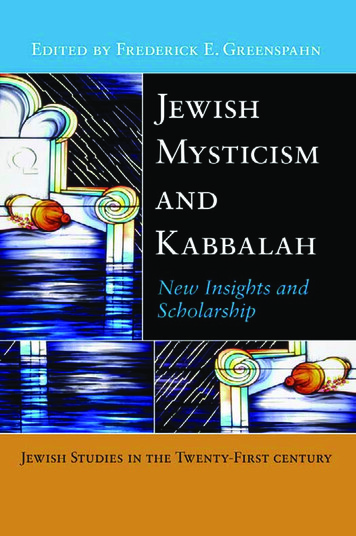
Transcription
Jewish Mysticism and Kabbalah
JEWI SH ST U DIE S IN T H E 2 1ST C E N T U RYGeneral Editor: Frederick E. GreenspahnThe Hebrew Bible: New Insights and ScholarshipEdited by Frederick E. GreenspahnWomen and Judaism: New Insights and ScholarshipEdited by Frederick E. GreenspahnJewish Mysticism and Kabbalah: New Insights and ScholarshipEdited by Frederick E. Greenspahn
Jewish Mysticismand KabbalahNew Insights and ScholarshipEdited by Frederick E. GreenspahnaNEW YORK UNIVERSIT Y PRESSNew York and London
NEW YORK UNIVERSITY PRESSNew York and Londonwww.nyupress.org 2011 by New York UniversityAll rights reservedReferences to Internet websites (URLs) were accurate at the time of writing.Neither the author nor New York University Press is responsible for URLsthat may have expired or changed since the manuscript was prepared.Library of Congress Cataloging-in-Publication DataJewish mysticism and Kabbalah : new insights and scholarship /edited by Frederick E. Greenspahn.p. cm. — (Jewish studies in the 21st century)Includes bibliographical references and index.ISBN 978–0–8147–3286–1 (cl : alk. paper) —ISBN 978–0–8147–3288–5 (e-book : alk. paper) —ISBN 978–0–8147–3319–6 (e-book : alk. paper)1. Cabala—History. 2. Mysticism—Judaism—History. 3. Judaism—History.I. Greenspahn, Frederick E., 1946–BM526.J49â â 2011296.1'6—dc23â â â â 2011020470New York University Press books are printed on acid-free paper,and their binding materials are chosen for strength and durability.We strive to use environmentally responsible suppliers and materialsto the greatest extent possible in publishing our books.Manufactured in the United States of America10â ‡9â ‡8â ‡7â ‡6â ‡5â ‡4â ‡3â ‡2â ‡1
ContentsPrefaceIntroduction: Reading Mysteries: The Origins of Scholarshipon Jewish MysticismHartley Lachtervii1I . J e w i s h M ys t i c i s m Ta k e s S h a p e1 Ancient Jewish MysticismMichael D. Swartz332 The Zohar: Masterpiece of Jewish MysticismEitan P. Fishbane493 Abraham ben Samuel Abulafia and the Prophetic KabbalahElliot R. Wolfson684 New Approaches to the Study of Kabbalistic Life in16th-Century SafedLawrence Fine91II. Becoming Modern5 Mystical Messianism: From the Renaissance tothe EnlightenmentMatt Goldish1156 Hasidism: Mystical and Nonmystical Approaches toInterpreting ScriptureShaul Magid1397 Christian KabbalahAllison P. Coudert159 â v
I I I . C o n t e m p o r a ry C o n c e r n s8 Kabbalah at the Turn of the 21st CenturyJody Myers1759 Gender in Jewish MysticismHava Tirosh-Samuelson191Epilogue: Kabbalah and Contemporary JudaismPinchas Giller231About the Contributors239Index241viâ â Contents
PrefaceIn 1957 Gershom Scholem, a world-renowned expert on Jewishmysticism, came to lecture at the Jewish Theological Seminary of America inNew York City. The introduction was delivered by Saul Lieberman, a prominent scholar of Jewish law. Lieberman began with the comment that “mysticism is nonsense, but the history of nonsense is scholarship.”1 Over the pasthalf-century, that remark has become a staple of academic Jewish lore.It was not always so. In the Middle Ages, Jewish thought was divided intothree parallel and, presumably, equal categories—rabbinic, philosophical,and mystical.2 Nor does Lieberman’s point resonate in our own time, whenbooks such as Kabbalah for Dummies3 can be found in mall bookstores, Kabbalah Centres attract celebrities like Madonna, Demi Moore, and BritneySpears, and Chabad Lubavitch is just about everywhere.Still, Lieberman’s attitude did not come out of nowhere. Jewish thinkershave long been suspicious of mystical quests. Two centuries ago, an anonymous work called Kol Sakal characterized Kabbalah as a heresy “which is nomore believable than the [beliefs of] Christians.”4 And two thousand yearsbefore that a Jewish sage warned, “Do not seek what is too wondrous for younor search for what is hidden from you . . . for you have no business dealingwith secrets.”5 The ancient rabbis echoed that sentiment when they speculated about the fact that the Bible begins with the second letter of the Hebrewalphabet: “Why was the world created with the letter bet?” they asked;“because just as the letter bet ( )ב is closed on the sides and open in front, sotoo you may not inquire what is above or below, what was before and whatwill be after, but only from the day since the world was created.”6 They citedthe case of a child who had wondered about the h.ashmal, an obscure termthat the prophet Ezekiel mentions as something he saw in the center of a fire(Ezek. 1:4, 27), only to be consumed by a fire that came forth from that veryh.ashmal.7 It is hardly surprising, therefore, that they prescribed that “the lawsof incest may not be expounded in the presence of three people, the story ofcreation in the presence of two, nor the chariot in the presence of one, unless â vii
he is a sage.”8 Even sages were not necessarily safe, judging from the storyof four eminent scholars who had entered a garden (a symbol of esotericthought) from which only one emerged intact.9Over the past generation, Jewish mysticism has attracted growing academic attention. One reason is that Jewish Studies blossomed on Americancampuses at about the same time that religious mysticism was attractingheightened attention. Many of those who experienced the spiritual revival ofthe 1960s are now professors at institutions of higher education, where theyhave applied academic methods to topics of personal interest. This congruence has yielded both remarkable insights and fierce controversy. In keepingwith the purpose of this series, this book strives to make both the fruits ofthose endeavors and the ensuing debates accessible to audiences beyond theacademy.In the introduction to this volume, after surveying the various expressionsof Jewish mysticism, Hartley Lachter describes the contribution of GershomScholem, whose importance for the academic study of Jewish mysticismwill become clear in the repeated references to his work that fill the following chapters. Scholem’s biography also demonstrates the complex interplaybetween personal motivation and scholarly research. Despite being an archrationalist who had little personal sympathy for mystical practice, it washe who, in many ways, brought attention to a phenomenon that had beenignored or dismissed all too often.The term mustikos, which is related to the word mystery, comes from aGreek root which means “teach” or “initiate into mysteries.” It was originallyused for secretive practices in the classical world.10 Christian tradition borrowed it to refer to the “spiritual” or “hidden meaning.”11The classic description of mysticism was provided by William James,who emphasized its concern with achieving “inner union with the divine.”12Although the ancient Jewish philosopher Philo argued that we cannot knowGod directly, but only “that He is,”13 mystical encounters have long been partof Jewish experience. The Bible itself records several direct encounters withGod, describing Moses as having spoken with God “mouth to mouth” (Num.12:8) and having known him “face to face” (Deut. 34:10). He is even said tohave seen God from behind (Exod. 24:23) and possibly His feet as well (Exod.24:10), this after having been told that one may not see God and live (v. 20).Later, Isaiah tells of seeing “the Lord sitting on a throne, high and lifted up,and His train filled the Temple” (6:1), while Ezekiel saw Him amid severalcreatures (Ezek. 1).viiiâ â Preface
Over the centuries that followed, Jews engaged in a remarkable array ofmystical endeavors, as described by Michael Swartz in the following chapter.This was the very period during which rabbinic Judaism produced its mostenduring works—the Talmud and the Midrashim. One cannot but wonderwhether this environment contributed to the rabbis’ concern about whatthey perceived as dangerous speculation, leading them to issue the warningsmentioned above.The classical period of Jewish mysticism was, beyond doubt, the MiddleAges, when a book called the Zohar was compiled and kabbalistic doctrinegiven its enduring shape by Isaac Luria. Kabbalistic tradition attributes theZohar to the 2nd-century Palestinian rabbi Shimon bar Yochai. That wouldcertainly support the impression that mysticism was a parallel and possiblycompetitive stream to the more familiar Jewish tradition as embodied in theTalmud. It was that view which Scholem challenged by demonstrating thatthe Zohar was actually the work of Moshe de Leon, a 13th-century SpanishKabbalist. As Eitan Fishbane explains in chapter 2, however, more recentscholarship has determined that the Zohar’s creation was far more complexthan previously thought. In so doing, he illustrates how modern scholarshipcan challenge both religious tradition and its own prior conclusions.The chapters on Abraham Abulafia and the mystical communities inSafed provide further illumination of this process. In the former, Elliot Wolfson describes recent scholarship’s demonstration that alongside the Zohar’stheosophical (theoretical) Kabbalah there existed another stream, called prophetic by Abraham Abulafia, which is deserving of equal attention. At thesame time, Lawrence Fine draws attention to the importance of consideringnontheological aspects of the Jewish mystical experience in his discussion ofthe practice, communal life, and role of women in the 16th-century mysticalcommunity at Safed, best known for the teachings of Isaac Luria (the “Ari”),which would become the normative form of kabbalistic theology.Recent scholarship has itself moved beyond describing the classical formsof Kabbalah in order to explore the breadth of its impact. For example, inthe next set of chapters Matt Goldish explains how Kabbalah provided theideological framework for numerous Jewish messianic movements, andAllison Coudert shows its impact on Christian thinkers and, through them,the development of modern science. Finally, Shaul Magid suggests that theHasidic movement, which is a modern expression of Jewish mysticism,used the Bible as a way of bringing the Jewish religious tradition, which hadfocused on the Talmud, into modernity.Prefaceâ â ix
We have clearly come a long way from those who thought of mysticism asa primitive form of thought and speculation—as “nonsense,” to use Lieberman’s term. It is now recognized as an integral part of the Jewish traditionand even a vehicle for Judaism’s modernization. Jody Myers reinforces thatpoint in chapter 8 by describing how Kabbalah has drawn on both Jewishand non-Jewish influences in order to flourish in the modern world. Nor hasits influence been limited to “exotic” movements, as Hava Tirosh-Samuelsonmakes clear in her examination of the growing interest in its treatment ofdivine gender, even if the androgynous elements of its theology are not asdeep as some modern thinkers might wish.The study of Kabbalah thus demonstrates the value of modern scholarship not only for understanding the various forms of Jewish mysticism butalso for appreciating the breadth of Judaism as a whole. In so doing, thatproject has brought several important questions to light:1.â ‡ Are the various Jews who have engaged in mystical endeavors connected?In other words, are the groups described in these pages isolated cases ofspiritual yearning or outward expressions of an ongoing mystical tradition? Put differently, are these phenomena distinct Jewish mysticisms, orcan we speak of a Jewish mystical tradition?2.â ‡ How is Jewish mysticism related to so-called normative (rabbinic) Judaism? Are they separate, possibly rival, streams or interconnected parts of acommon tradition? Taking that line of reasoning further, can the mysticaltradition even be separated from “mainstream” Judaism? After all, JosephKaro compiled the normative code of Jewish law while living in the 16thcentury kabbalistic community at Safed. Analogously, many practices thatare mainstays of contemporary Jewish life, such as the Kabbalat Shabbat liturgy which opens Sabbath worship, the Tu Bi-Shevat seder, late-night studyon certain holidays, and even the popular phrase tikkun olam, originatedwithin the mystical tradition.3.â ‡ To what extent is Jewish mysticism related to other traditions? Severalchapters of this book allude to the possibility that kabbalistic practices hadbeen borrowed from Christianity or Islam. The reverse may have takenplace as well. The messianic claimants Shabbatai Zevi and Jacob Frank,who lived in the 17th and 18th centuries, ended up converting to Islamand Christianity respectively, and one 14th-century scholar claimed thatJesus and his disciples were actually Kabbalists, albeit confused ones.14 Better documented is Kabbalah’s influence on the Christian Renaissance and,through it, on early modern thought.xâ â Preface
4.â ‡ What can these movements teach us about mysticism as a whole? WhenWilliam James formulated the classical description of mysticism a century ago, he cited evidence from several religious communities, mentioning Hinduism, Buddhism, Mohammedanism, and Christianity by name.15Judaism is conspicuously absent from this list. Did James think that Judaism had not produced mystical activity, or was his definition flawed? Aswe shall see, figures such as the merkavah mystics and Abraham Abulafia strove for direct contact with God, a longing that continues in MartinBuber’s description of God as the “eternal Thou” (der ewige du).16 Others,however, such as the authors of the Zohar, seem to have been more interested in understanding the divine than in experiencing it.5.â ‡ Finally, what can these mystical phenomena teach us about Judaism as awhole? Were the Jewish mystics a small handful of heretics, or did theyconstitute a significant stream of Jewish experience which the rabbissought to marginalize? Should the latter prove to be true, then we will haveto contend with the possibility that our own understanding of Judaismmay have been limited by the rabbis’ efforts to define what was normativeand what was not. If so, then the commitment of modern Jewish Studiesto observing and then describing the behavior of actual Jews rather thanstudying only what their leaders tell them can help us recapture a broaderunderstanding of Jewish life and practice.These are not simple questions, nor do the results always match our expectations. In the end, that is the value of the scholarly approach—its commitment to starting with evidence rather than beliefs or assumptions and payingattention to what people actually do as well as what their leaders teach. If theconclusions then force us to revise our theories or our categories, that simply demonstrates the self-correcting nature of the scholarly enterprise, wherechange is ever present and error a sign of vitality rather than a flaw.17To be sure, scholarship’s inability to stand still can be confusing. Its abilityto let us know more than previous generations knew comes at the expense ofproving that these earlier interpretations were inadequate or sometimes incorrect. That, in turn, suggests the possibility that what we know today, including the contents of this book, may be superseded as research continues and ourknowledge grows. That may be unsettling—we all crave certainty—but it is alsoa sign of liveliness, that we continue to learn more as new discoveries emergeout of those that came before. In the epilogue to this book, Pinchas Giller reiterates the value of moving forward with the recognition that it is the achievements of those who came before which enable us to question their conclusions.Prefaceâ â xi
There may be those who, like Saul Lieberman more than sixty years ago,dismiss the phenomena described in these pages, questioning whetherChabad is mystical or the Kabbalah Centres Jewish. We should not be put offby the success of such movements, however; that, too, is better recognized asevidence of Judaism’s richness and dynamism than its decay. One goal of thisbook is to share the excitement of understanding where these phenomena fitinto the spectrum of Jewish tradition by presenting the current state of ourknowledge, even as scholars strive for deeper and broader understanding.Many individuals have contributed to this project. The seeds of theentire undertaking were sown by Herbert and Elaine Gimelstob, withoutwhose generosity it would have been inconceivable. Alan Berger, KristenLindbeck, and Marianne Sanua helped turn that vision into a concreteplan. Their abstract outline was fleshed out with guidance from ArthurGreen and Lawrence Fine. As always, Jennifer Hammer participated frombeginning to end, ensuring the cohesion and coherence of the resultingproduct, while Nicole Jacobsen provided visual images that could clarifythese ideas and Inbal Mazar ensured that the effort was smoothly and professionally executed. Finally, Barbara Pearl has made my vision her own,contributing her unique warmth and nurturance so that the result couldbe rewarding, enlightening, and enjoyable. It has been my good fortune toshare both the experience and its product with her, along with the entiretyof our lives.Notes1. The remark was later published in an appendix to Lieberman’s article “How MuchGreek in Jewish Palestine?” in Biblical and Other Studies, ed. Alexander Altmann (Cambridge, MA: Harvard University Press, 1963), p. 135; see Abe Socher, “The History ofNonsense,” AJS Perspectives (fall 2006): 32.2. Profiat Duran, Ma‘aseh Ephod, ed. Jonathan Friedländer and Jakob Kohn (Vienna:J. Holzworth, 1865), pp. 4–9; cf. Simone Luzzatto’s Discourse on the State of the Jews, asdescribed by Robert Bonfils, “A Cultural Profile,” in The Jews of Early Modern Venice, ed.Robert C. Davis and Benjamin Ravid (Baltimore: Johns Hopkins University Press, 2001),pp. 170–71.3. Arthur Kurzweil, Kabbalah for Dummies (Hoboken, NJ: Wiley, 2006); cf. MichaelLaitman and Collin Canright, The Complete Idiot’s Guide to Kabbalah (Indianapolis: AlphaBooks, 2007).4. Talya Fishman, Shaking the Pillars of Exile, “Voice of a Fool,” An Early Modern JewishCritique of Rabbinic Culture (Stanford: Stanford University Press, 1997), p. 115.5. Sirah 3:21–22.6. Gen. Rabb. 1:107. B. H.ag. 13a.xiiâ â Preface
8. M. H.ag. 2:1; cf. the prologue to Origen’s commentary to the Song of Songs §1 (ed. R.P. Lawson; Westminster, MD: Newman, 1957, p. 23); and Jerome’s letter to Paulinus (letter53, §8 in Nicene and Post-Nicene Fathers, ed. Philip Schaff and Henry Wace, 2d ser. [Edinburgh: T & T Clark, 1893], 6:101).9. T. H.ag. 2:3–4,; j. H.ag. 2:1, 77b; b. H.ag. 14b; and Cant. Rabb. 1:4.10. E.g., Thucydides, History of the Peloponnesian War VI.xxviii.2 (LCL 3:232–33), VI.lx.1(LCL 3:286–87); Herodotus, The Persian Wars VIII.65 (LCL 4:60–61); Strabo, GeographyXVII.i.29 (LCL 8:82–84).11. Louis Dupré, “Mysticism,” in Encyclopedia of Religion, ed. Mircea Eliade (New York:Macmillan, 1987), 10:245–46.12. William James, The Varieties of Religious Experience: A Study in Human Nature [1902](New York: Random House, 1929), p. 420. The apostle Paul captured that attitude nicelywhen he wrote, “I live, yet not I but Christ lives in me” (Gal. 2:20).13. On Rewards and Punishments VII.44 (LCL 8:338–39); cf. Maimonides’ view that wecan only know what God is not (The Guide of the Perplexed 1:51, 58, trans. Shlomo Pines[Chicago: University of Chicago Press, 1963]), pp. 112, 134).14. Profiat Duran, Kelimat Ha-Goyim, ed. Adolf Poznanski in Ha-S.ofeh 3, p. 143, as citedby Gershom Scholem, “Zur Geschichte der Anfänge der christlichen Kabbala,” in EssaysPresented to Leo Baeck on the Occasion of His Eightieth Birthday (London: East and WestLibrary, 1954), p. 177, note 2.15. Ibid., p. 391.16. Martin Buber, I and Thou (New York: Scribner’s Sons, 1958), pp. 100–101, cf. p. 112.17. This is Thomas S. Kuhn’s classic point in The Structure of Scientific Revolutions (Chicago: University of Chicago Press, 1962).Prefaceâ â xiii
This page intentionally left blank
Introduction: Reading MysteriesThe Origins of Scholarship on Jewish MysticismHa rt l ey L achterWhy would someone who does not identify as a Jewish mystic wantto study Jewish mystical texts? All modern academics who have chosento examine texts and ideas from the Jewish mystical tradition have had toaddress this question in one way or another. As we shall see, a wide rangeof answers to this question can be inferred from the history of scholarship,but a general feature that academic studies of Jewish mysticism share is theassumption that a detailed examination of Jewish mystical texts and discourse, as it has taken shape in different locations over the course of history,has something important to contribute to our understanding of humanity.The studies in this volume represent the current state of research in thevarious subfields of the study of Jewish mysticism. In order to better appreciate their contributions, it is important to understand both the history ofJewish mystical literature and the history of academic scholarship about Jewish mystical texts. To that end, we provide a sketch of the history of Jewishmysticism followed by an overview of the main concerns and ideas that gaverise to the academic study of Jewish mysticism as it exists today.A Brief History of Jewish MysticismBiblical PrecursorsThe Hebrew Bible is a primary source of reflection and inspiration for virtually all branches of Jewish mysticism. Although we must be careful not toconflate the religion of the ancient Israelites with later periods of Jewish history, it remains clear that there are certain elements of continuity. One ofthe most important ideas of biblical religion that impacted Jewish mysticismis the phenomenon of prophecy and revelatory experience. The texts relating the revelations to Abraham, Isaac, Jacob, Moses, the people of Israel asa whole at Sinai, and the prophetic inspirations and visions of Ezekiel, Dan â 1
iel, and other prominent personalities in the Bible serve as the foundationfor much of the esoteric and mystical traditions of Judaism. The Zohar, forexample, is organized as a commentary on the Torah, and contains manydescriptions of the Divine experience that approximate descriptions of prophetic revelation found throughout the Bible.1st–7th Centuries: Early Jewish Mysticism and EsotericismPostbiblical Jewish mysticism and esotericism began in the ancient Near Eastwith a number of important texts that draw upon biblical images, such asEzekiel’s vision of the divine chariot (merkavah) and the ascension of Enoch(Gen. 5:21–24). The rabbinic literature of the Talmud and Midrash also contains many images and ideas about the mysteries of the divine realm, thenature of prophecy, the origins of the cosmos, the nature of the human soul,and other matters that went on to have a significant influence on later formsof Jewish mystical discourse.Rabbinic LiteratureA prominent feature of mystical literature is the claim that the knowledge conveyed by the text is “esoteric,” meaning secret, restricted, or, in somecases, intellectually incomprehensible. Descriptions of esoteric speculationcan be found in a number of places in the Talmud and Midrashim. In onefamous example, we read: “forbidden sexual relations may not be expoundedbefore three [or more] people, nor the account of creation [ma‘aseh bereishit]before two [or more], nor the account of the Chariot [ma‘aseh merkavah]before one, unless he is a sage who understands through his own knowledge.”1 These categories of forbidden or restricted speculation indicate a tradition, already active in the first few centuries of the Common Era amongthe rabbinic elite, of secret knowledge regarding God, the creation of theuniverse, and human sexuality.The Hekhalot and Merkavah LiteratureAnother group of Jewish mystical texts from the first centuries of the Common Era discusses the means of traversing the seven courtyards (hekhalot) orchambers that surround the divine throne or chariot (merkavah). Each stageof the journey involves entering through the gateways between the courtyards,which are guarded by angels. Only those who are fully adept in the proper reci2â â Hartley Lachter
tation of the angelic names can enter and exit unharmed. These visions arereported in the names of famous personalities from the rabbinic schools, suchas Rabbi Akiva and Rabbi Ishmael. The precise connections between this bodyof literature and the rabbinic authors are difficult to determine, but most scholars agree that the traditions related in the Hekhalot and Merkavah literature,especially those texts from the Hekhalot Rabbati and Hekhalot Zutarti collections, date to the rabbinic period.The Sefer YetsirahThe Sefer Yetsirah (Book of Creation), composed sometime between the2nd and 7th centuries CE, is a short treatise of fewer than two thousandwords that discusses the creation of the universe by means of the twentytwo letters of the Hebrew alphabet and the ten “ineffable sefirot.” It is unclearwhat the ten sefirot exactly are in this context, but they seem to be entitiesin the divine realm that are incomprehensible to the human mind and yetrepresent the mysterious nature of God and serve as His tools in the creativeprocess. The focus on the symbolism of the ten sefirot and the letters of theHebrew alphabet in the Sefer Yetsirah had a major impact on later Jewishmysticism and Kabbalah.The Shi‘ur QomahOne of the most arcane texts from the ancient period of Jewish mysticismand esotericism is the unusual collection of passages referred to as the Shi‘urQomah (Measure of the Stature). These texts describe the glory of God inthe form of a celestial human body of enormous proportions, with namesassociated with each limb. Anthropomorphic representations of God play animportant role in later periods of Jewish mysticism.7th–11th Centuries: Mysticism in the Geonic PeriodMuch of what we find from the 7th to the 11th century reflects a strong influence from the rabbinic and Hekhalot/Merkavah sources. Nonetheless, asGershom Scholem has noted, a number of important ideas that had a significant impact on later Jewish mysticism developed during this period.2The first of these, building on ideas that began during the rabbinic period, isthe re-conceptualization of the Shekhinah (Divine Presence) as more than aname for the presence of God in the world but rather a kind of hypostasis orIntroduction: Reading Mysteriesâ â 3
entity that can interact with God. Furthermore, it was during this period thatimportant notions became widespread: the association between the Shekhinah and Knesset Yisrael (the community of Israel), the first appearance inJudaism of the idea of reincarnation (gilgul), and the application of numerology (gematria) to the values of Hebrew letters and words in order to uncoversecrets (sodot) hidden within biblical texts.Two important commentaries on the Sefer Yetsirah were composed during this period, one by Shabbatai ben Abraham Donnolo (913–ca. 982) andanother by Judah ben Barzillai al-Barceloni (late 11th–early 12th century).During the early part of the geonic period, most of the important authorswere centered in Babylonia, but later many of these ideas began to spread tothe Jewish communities of Europe.12th–13th Centuries:Medieval Jewish Mysticism and the Rise of KabbalahThe H. asidei AshkenazA significant development in the promulgation of mystical and esotericideas in the Jewish communities of Western Christendom was the emergence of a group in the Rhineland known as the H.asidei Ashkenaz (German Pietists). This movement, which was active from roughly 1250 to 1350,had a profound impact on the kabbalistic circles in Spain in the latter partof the 13th century. Its three main figures came from the Kalonymide family, starting with Samuel the H. asid (mid-12th century), the son of RabbiKalonymus of Speyer, Judah the H.asid of Worms (d. 1217), and Eleazar benYehuda of Worms, who died between 1223 and 1232. Although little of the literary activity of Samuel the H.asid remains, many associate the Sefer H. asidim(Book of the Pious) with the teachings of Judah the H. asid. Eleazar of Wormscomposed numerous works—some of considerable length—that have survived and serve as the most important evidence of this group’s mysticalspeculations.The H.asidei Ashkenaz placed particular emphasis on ascetic renunciationand ethical discipline. Fasts, abstinence, physical pain and discomfort, andeven martyrdom were all regarded as vehicles to enable mystical illumination, especially in the form of visualizing the Shekhinah. According to theH.asidei Ashkenaz, God’s essence is unknowable, and yet He fills all realityand suffuses all being. By practicing ascetic renunciation and contemplating the traditional teachings of the divine mysteries regarding creation,revelation, and the meaning of the Torah, members of this school believed4â â Hartley Lachter
that they could attain the pure love of God in an encounter that was oftendescribed in ways that indicate a strong influence from the Hekhalot andMerkavah literature, as well as the Sefer Yetsirah. Many scholars believe thatthe tribulations of the Crusades and the ascetic practices of the surroundingChristian monastic communities had an impact on the particular form ofreligious and mystical piety of the H. asidei Ashkenaz.Kabbalah in Provence and the Sefer ha-BahirIn the 1180s, a text emerged in the Provence region of southern France thathas come to serve as a defining moment in the history of Jewish mysticismand esotericism. This text, known as the Sefer ha-Bahir (Book of Brightness),is written in the style of an ancient rabbinic Midrash. The book has a complex origin and contains at least some elements that are believed to reflectancient Near Eastern Jewish traditions. Determining the exact proportion ofthe Bahir that derives from ancient tradition and specifying the innovationof authors living in 12th-century Europe remains an open question in thescholarly literature. The most sign
of Kabbalah in order to explore the breadth of its impact. For example, in the next set of chapters Matt Goldish explains how Kabbalah provided the ideological framework for numerous Jewish messianic movements, and Allison Coudert shows its impact on Christian think
